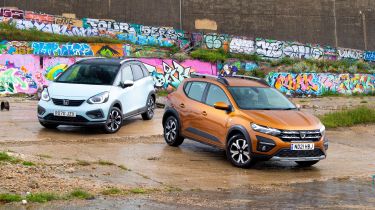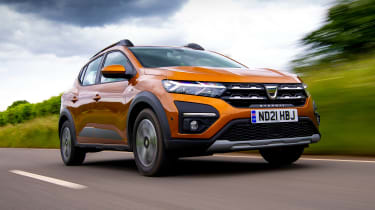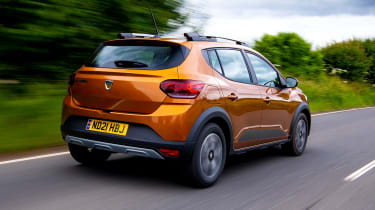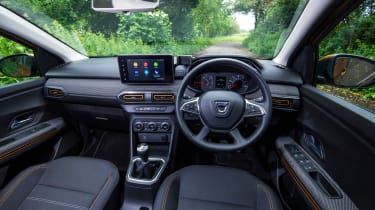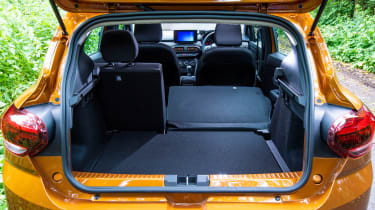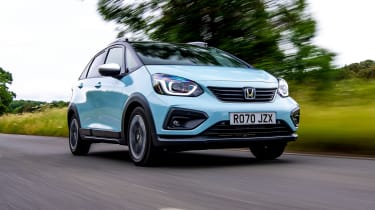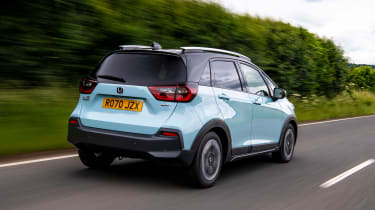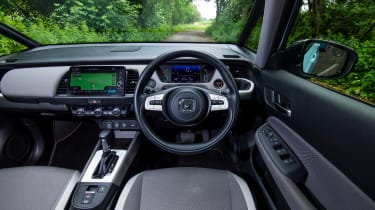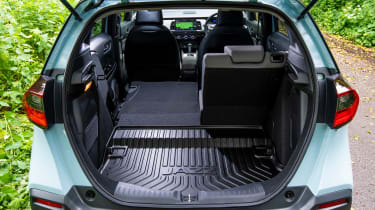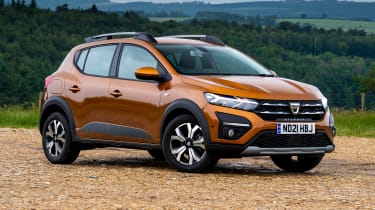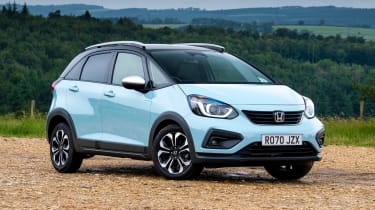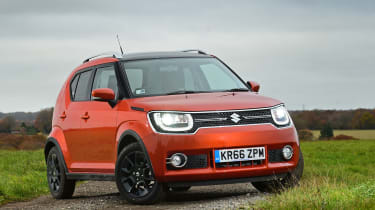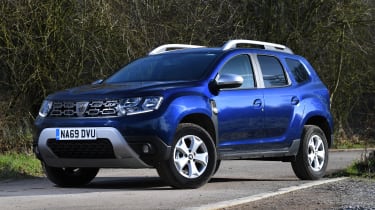Honda Jazz Crosstar vs Dacia Sandero Stepway
SUV ruggedness comes to the supermini genre courtesy of the Honda Jazz Crosstar and Dacia Sandero Stepway - but which is best?
These days, SUVs are available in all shapes and sizes, and their styling influence is pervading classes well beyond the 4x4 sector. We haven’t quite got to the stage of a manufacturer offering a plastic-clad high-riding sports car (we wouldn’t bet against it, though), but these days you can get estates, city cars and even vans with a rugged 4x4 look, even if they are unlikely to offer any additional off-road ability.
Here we’re trying a pair of superminis that have raided the SUV dress-up box, creating flagships for their respective ranges in the process. The second-generation Dacia Sandero Stepway maintains the same formula as its predecessor, by offering a rugged-looking, practical body in a great-value package, but the latest model is a clear step forward in terms of both quality and tech.
Then there’s the Honda Jazz Crosstar. The Jazz has always been a practical choice, but it’s suffered from a bit of an image problem that this high-riding variant is attempting to redress, while its hybrid drivetrain promises great urban efficiency.
There’s a significant price gap between these two models, but which one wears its SUV-inspired style best and has the ability to cope with the rough and tumble of urban life?
Dacia Sandero Stepway
| Model: | Dacia Sandero Stepway TCe 90 Prestige |
| Price: | £14,295 |
| Engine: | 1.0-litre 3cyl turbo petrol, 89bhp |
| 0-62mph: | 12.0 seconds |
| Test economy: | 44.3mpg/9.7mpl |
| CO2: | 127g/km |
| Annual road tax: | £155 |
The second-generation Sandero Stepway arrived at the start of 2021, and as with the original, it’s based on the standard Sandero supermini. It comes in three trims, but even the top-spec Prestige model tested here is a relative bargain when compared
with the Honda, coming in at £14,295.
Used - available now

2015 Dacia
Sandero Stepway
68,470 milesManualDiesel1.5L
Cash £3,795
2022 Dacia
Sandero Stepway
9,000 milesManualPetrol1.0L
Cash £11,450
2022 Dacia
Sandero Stepway
4,827 milesManualPetrol1.0L
Cash £11,845
2024 Dacia
Sandero Stepway
46,640 milesManualPetrol-lpg1.0L
Cash £10,058Design & engineering
The secret to Dacia’s value-for-money pricing is its reliance on parent firm Renault for its technology and engineering. This cuts development costs for the Romanian brand dramatically, but since Dacia has access to Renault’s latest tech, it means that very few corners are cut. Under the Sandero’s skin is a budget version of the platform used by the current Renault Clio, and the Dacia uses the same engines, too.
Parts sharing like this can sometimes make the benefactor feel like a knock-off of the original, but that’s not the case here. While the Sandero is a similar size to the Clio, it has its own look, with a large grille and headlights featuring arrow-themed daytime running lights. This Stepway model is raised by 39mm and gets metal-effect skidplates front and rear, black plastic wheelarch extensions and roof bars. The only obvious concession to cost-cutting – and it’s not a big one – is on the lower doors; while the Jazz Crosstar has plastic cladding, the Dacia makes do with matt-black decals. At least they still offer some paintwork protection.
Step inside and you’ll find some switches and controls that are shared with the Clio – the steering wheel and climate controls are identical – but the Sandero has a different overall dashboard design, so the similarities are slight. Hard plastics dominate the cabin, but the Stepway adds silver trim highlights, while light grey fabric across the dashboard and on the door armrests breaks up the monotony.
Standard kit is reasonable, although the Sandero doesn’t have some of the more cutting-edge features seen in the Jazz, such as adaptive cruise control, heated seats, a digital dashboard or connected services. You do get touchscreen infotainment with smartphone connectivity, though, plus air-conditioning and parking sensors front and rear, and the Dacia certainly doesn’t feel as basic as its price would suggest.
Driving
One aspect of the Sandero that is different from the Clio – and is lacking when compared with the Jazz – is the driving experience. While the Dacia and Renault both use the CMF-B platform, there are high and low-spec versions, and Dacia uses the latter with a more basic suspension set-up.
The Sandero is perfectly pleasant to drive, but it doesn’t offer much in the way of fun. The steering is direct enough, without delivering much feedback, but the Jazz feels livelier and keener in corners.
Where the Sandero impresses is with its comfort. Dacia has used the Stepway’s raised ride height to add some extra travel to the suspension, and while it’s no luxury car, it does a better job of ironing out bumps than the Jazz.
However, cruising refinement is hampered by a lack of sound deadening around the car that lets additional road, wind and engine noise into the cabin. It’s by no means harsh, but at higher speeds you’ll need to raise your voice to have a conversation or turn the volume up to hear the radio.
Engine noise is exacerbated because you have to work the 89bhp 1.0-litre TCe three-cylinder turbo petrol to make the most of it. In addition, a jerky throttle response and spongy gearchange put a bit of a dampener on driving enjoyment, too.
Practicality
A slightly raised ride height boosts access to the Sandero’s cabin, and space inside is good, too. The Dacia is 123mm wider than the Honda, so there’s more room in the back for three passengers to get comfortable, and while the Sandero is slightly lower than the Jazz overall, it still has more headroom. Front-seat passengers get some fabric trim on the dashboard and doors to break up the swathe of hard black plastics, but the back doors don’t feature this, leaving a rather dark cabin in the rear.
Boot space is up on the Jazz, at 328 litres (30 litres ahead), although the Dacia has a higher load lip to lift items over. The tables are turned when it comes to outright carrying capacity with the 60:40 split back seats folded; the Sandero has a boot volume of 1,108 litres, which lags 91 litres behind the Honda’s.
Ownership
Something that might ring alarm bells for potential Sandero buyers is the car’s two-star Euro NCAP safety score. It’s true that the Sandero doesn’t have the latest electronic safety equipment like the Jazz (or the Clio that it shares so much with), but this rating doesn’t mean that it’s unsafe. Euro NCAP now requires cars to have a minimum level of safety kit to earn a higher rating, and while the Dacia’s percentage scores aren’t as good as the Honda’s, either, the Sandero will still be safer than a second-hand car of a similar price.
You still get automatic emergency braking, though, while the Stepway adds blind-spot detection, front and rear parking sensors, and a reversing camera, so at least there’s kit on board to help you avoid an incident in the first place.
Running costs
The Sandero Stepway’s list price of £14,295 is nearly £10k less than the Jazz Crosstar’s, and you’d only add another £1,200 to that if you wanted to match the Honda’s auto gearbox. However, when lined up side by side, the Sandero Stepway doesn’t feel like it’s £10k cheaper.
Private buyers will lose less cash on their investment, too, and not just because they’re paying less in the first place. A residual value of 51.6 per cent is ahead of the Jazz Crosstar’s, at 50.3 per cent.
Testers’ notes
“From the outside, the Sandero looks like it has a narrow back window, but a shortage of rearward visibility from the driver’s seat is never an issue.”
Honda Jazz Crosstar
| Model: | Honda Jazz 1.5 i-MMD Crosstar EX |
| Price: | £23,445 |
| Engine: | 1.5-litre 4cyl hybrid petrol, 108bhp |
| 0-62mph: | 9.9 seconds |
| Test economy: | 55.4mpg/12.2mpl |
| CO2: | 110g/km |
| Annual road tax: | £155 |
It’s the Honda Jazz’s 20th anniversary in 2021. For two decades the Jazz (or the Fit, as it’s known in Japan) has provided sensible and reliable supermini transport. This Crosstar version is the first real departure for it in terms of design and is the flagship model of the range, costing £23,445.
Design & engineering
While the looks have evolved over the years, the Honda Jazz has always come solely as a one-box, five-door hatchback, and the fourth generation, launched in 2020, is no different. However, as with the Sandero Stepway, the Crosstar version gets a chunky visual makeover, with roof rails, a raised ride height and plastic cladding. There are no fake skidplates like the Dacia’s, but the Crosstar does get a traditional grille whereas the standard Jazz has a smooth nose.
Inside, the cabin has a look reminiscent of the all-electric Honda e. It’s lacking the drama of that car’s panoramic displays, but the two-spoke multifunction steering wheel, prominent touchscreen, ivory-white trim pieces, water-resistant upholstery and fabric-topped dashboard and armrests are highlights. These elements combine with great build quality to justify the Jazz’s price premium over the Dacia.
Under the skin is where you’ll find the other reason why the Honda costs so much more than its petrol-only rival from Dacia. As with the rest of the Jazz range, the Crosstar is powered by Honda’s hybrid drive system, tech that this car pioneered. It comprises a 1.5-litre petrol engine, electric motor set-up, battery and CVT automatic gearbox, and the system is geared towards running in electric mode as much as possible. The engine only really kicks in when extra power is needed, so in town you’re driving on the electric motor most of the time.
Driving
With a focus on efficiency, you might expect the Honda to feel rather dull to drive, but the truth is that it’s surprisingly sprightly. Fast steering and a nimble chassis mean it’s actually quite fun. There’s good grip and sharp turn-in, while the rear end is eager to follow when you change direction, so the Jazz is able to entertain whether you’re dealing with the cut and thrust of urban traffic, or you’re tackling a twistier country road.
This is good news, because the hybrid system’s narrow torque band means you’ll be trying to maintain momentum wherever you go. While the Jazz’s electric motor helps to fill in when the CVT gearbox turns engine revs into forward motion, and a 0-62mph time of 9.9 seconds is certainly faster than the Dacia’s 12-second time, you couldn’t call the Honda rapid. If you want to build speed in a hurry, you’re out of luck; the engine revs soar, but the car doesn’t gather pace at the same rate. We’d recommend giving yourself more time than you think when exiting junctions into traffic. Decent soundproofing means that while the revs soar when you accelerate, it’s not particularly intrusive and vibration is minimal.
The pay-off for the Honda’s fun handling is that it has a rather firm ride when compared with the Dacia. While the Crosstar is 30mm taller than the standard Jazz, the suspension hasn’t been given any extra travel. In fact, from past experience of the two variants, the Crosstar’s suspension is firmer than the standard car’s. It’s not to the point of being uncomfortable, but small imperfections in the road are more easily felt here than they are in the Sandero. It’s a shame, really, because otherwise the Jazz is a surprisingly accomplished supermini.
Practicality
While the Jazz is shorter and narrower than the Sandero, clever packaging means that the difference in space inside isn’t that stark. The obvious area where the Honda takes a hit is across the back seats, because there isn��t nearly as much shoulder room as you’ll find in the Dacia. That means it’s tighter if you’re travelling five-up, but space is still more than adequate for four.
Boot space in the Jazz is smaller by 30 litres, but the Honda has a lower load lip than the Sandero, while that grey plastic rear bumper will be more resistant to scratches than the Dacia’s painted sill.
Of course, the Jazz’s party piece is its Magic Seat layout, which has been retained for this fourth-generation model. As well as the 60:40 split seat backs that fold completely flat, the cushions also flip up cinema-style to create a second load compartment between the boot and the front seats. This makes loading tall, narrow items a breeze.
Ownership
Pay a premium for the Jazz and you’ll benefit from Honda’s customer service. The company came second only to Lexus in our 2020 Driver Power dealer poll, so it’s at the front of the pack for mainstream dealer service.
We didn’t have enough responses from Dacia owners for its franchises to rank in our dealership survey, but it came 30th in the manufacturer poll, while Honda placed in seventh.
Running costs
Honda’s i-MMD hybrid system offers the potential for great efficiency, and so it proved on test. We averaged 55.4mpg, compared with 44.3mpg for the Dacia. However, the Honda’s modest 40-litre fuel tank is 10 litres down on the Sandero’s, and both cars offered the same 487-mile range on a tank of petrol. However, how and where you drive will likely determine how efficient the Jazz is, with urban low-speed driving showing the hybrid system in a more favourable light.
Emissions of 110g/km are 17g/km less than the Sandero Stepway’s. While that means the Honda sits three brackets below the Dacia for company car tax (26 per cent to 29 per cent), the Sandero’s significantly lower P11D price means it’s still the cheaper company car option.
Testers’ notes
“A shallow cowl over the instruments means they can be affected by sunlight. The main screen is fine, but the readouts on either side can be hard to see.”
Verdict
First place: Dacia Sandero
The Sandero Stepway offers fantastic value for money, and yet in top-spec Prestige trim it doesn’t feel like a budget machine. There’s plenty of space in the cabin and boot, and it uses its high-riding suspension to deliver a more comfortable ride than the Jazz. Yes, there are hard plastics inside, but adding fabric trim in the right places means the Stepway hides its value-for-money roots well.
Second place: Honda Jazz Crosstar
Hybrid tech means that the Jazz Crosstar delivers great efficiency, and the little Honda is surprisingly enjoyable to drive, too. However, the same can be said of any current Jazz. Factor in a firmer ride than the standard car’s and you’d have to really like the Crosstar’s looks to choose it. We’d pocket the £1,200 extra and take an EX model; it’s just as practical and even more efficient.
Also consider...
New: Suzuki Ignis SZ5 AllGrip
Price: £17,999
Engine: 1.2-litre 4cyl, 83bhp
If you need a supermini with actual off-road ability and chunky, funky looks, then the Ignis offers the value of the Sandero, but with tech like the Jazz. Suzuki is currently offering a £2,000 deposit contribution on its baby 4x4, too.
Used: Dacia Duster 1.3 TCe 130 Prestige
Price: £14,000
Engine: 1.3-litre 4cyl, 128bhp
The only thing more impressive than a great-value new Dacia is an even greater-value used one. A £14k budget can bag you a current-shape 2019 Duster with 1.3 TCe power in top Prestige trim. It won’t have the latest tech, but it’ll be a practical machine.
Figures
| Dacia Sandero Stepway TCe 90 Prestige | Honda Jazz 1.5 i-MMD Crosstar EX | |
| On the road price/total as tested | £14,295/£15,140 | £23,445/£24,595 |
| Residual value (after 3yrs/36,000) | £7,376/51.6% | £11,793/50.3% |
| Depreciation | £6,919 | £11,652 |
| Annual tax liability std/higher rate | £815/£1,631 | £1,208/£2,417 |
| Annual fuel cost (12k/20k miles) | £1,635/£2,726 | £1,308/£2,179 |
| Ins. group/quote/VED | 14/£407/£155 | 19/£401/£155 |
| Cost of 1st/2nd/3rd service | £399 (3yrs/30k) | £260/£330/£310 |
| Length/wheelbase | 4,099/2,604mm | 4,090/2,520mm |
| Height/width | 1,535/1848mm | 1,556/1,725mm |
| Engine | 3cyl in-line/999cc | 4cyl in-line/1,498cc |
| Peak power/revs | 89/4,600 bhp/rpm | 108/5,500 bhp/rpm |
| Peak torque/revs | 160/2,100 Nm/rpm | 253/4,500 Nm/rpm |
| Transmission | 6-spd manual/fwd | CVT auto/fwd |
| Fuel tank capacity/spare wheel | 50 litres/£199 | 40 litres/repair kit |
| Boot capacity (seats up/down) | 328/1,108 litres | 298/1,199 litres |
| Kerbweight/payload/towing weight | 1,096/377/1,100kg | 1,253/457kg |
| Turning circle | 10.4 metres | 10.1 metres |
| Basic warranty/recovery | 3yrs/3yrs | 3yrs*/1yr |
| Driver Power manufacturer/dealer pos | 30th/N/A | 7th/2nd |
| NCAP: Adult/child/ped./assist/stars | 70/72/41/42/2 (’21) | 87/83/80/76/5 (’20) |
| 0-62mph/top speed | 12.0 secs/107mph | 9.9 secs/107mph |
| Auto Express economy/range | 44.3/9.7/487 miles | 55.4/12.2/487 miles |
| WLTP combined | 55.4mpg | 58.9mpg |
| WLTP combined | 12.2mpl | 13.0mpl |
| Actual/claimed CO2/tax bracket | 147/127g/km/29% | 137/110g/km/26% |
| Airbags/Isofix/park sensors/camera | Six/yes/F&R/yes | Seven/yes/F&R/yes |
| Auto box/lane keep/blindspot/AEB | £1,200/no/yes/yes | Yes/yes/no/yes |
| Climate control/cruise conrol | No/yes | Yes/adaptive |
| Leather/heated seats | No/no | No/yes |
| Met paint/LED lights | £595/yes | £550/yes |
| Keyless entry & go/power tailgate | No/no | Yes/no |
| Sat-nav/digital dash | Yes/no | Yes/yes |
| DAB/connected services | Yes/no | Yes/yes |
| Wireless charge/CarPlay/Android Auto | No/wireless/yes | No/wireless/yes |
